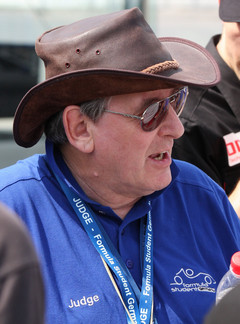Well, 2009 is here and we are in the count-down to FSG in August.
As Birgit has already reported, the available registrations filled up within 8 seconds when the registration server and nearly 40 teams were unable to register. This has become the subject of some hot debate, both on this site and in other places.
I can really understand the disappointment of teams who missed registration and have read all of the suggestions posted. Most are suggesting squeezing in more entrants, running extra in Endurance, starting earlier, finishing later etc. That was the path followed by FSAE in the US when entries started to exceed available slots.
The result was an event where Design was reduced to 20 minutes per car, strict deadlines were placed on events regardless of hold-ups that were no fault of the entrants, very strict scrutineering that culled the number of teams allowed on track and then rigid stewarding that had teams black-flagged from the events for minor infractions. All this in an attempt to fit everything into the time available. The result was an event that became an unsatisfactory experience for many teams.
FSG started out with a policy of fairness and with the interests of the students at heart. Squeezing in more entries might temporarily satisfy a few who would not otherwise have got a start, but at the expense of all teams having a less pleasant experience.
Certainly, there will be long discussions among the organisers to improve matters, and I am sure they will welcome positive suggestions. I would ask that you think through any suggestion before you make them, as something that seems simple to you may significantly impact other aspects of the event.
Now, to open a real can of worms.
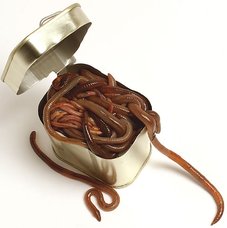 The 2009 rules have introduced the dreaded templates. No single subject has generated so much communication with the rules committee in the life of the event. The evolution of the FS car had seen short wheelbases with the front wheels roughly alongside the driver’s knees. This put the steering gear in close proximity to the driver’s legs.
The 2009 rules have introduced the dreaded templates. No single subject has generated so much communication with the rules committee in the life of the event. The evolution of the FS car had seen short wheelbases with the front wheels roughly alongside the driver’s knees. This put the steering gear in close proximity to the driver’s legs.
A second problem with these evolution cars was the chassis was being made very narrow. This was a result of the designer’s attempts to retain a narrow track whilst retaining adequate suspension geometry.
The Judges and Scrutineers watched this happen progressively. Initially the Judges started penalising designs where they determined the driver was at risk from the steering rack in the event of an accident. The Scrutineers were insisting the students pad and cover components, but in many cases were very unhappy with the design of the cars.
At about this time, there were a couple of significant crashes in FSAE cars (one being the very high profile Cornell car), fortunately not at any sanctioned event, which further highlighted the potential of serious leg injury, or even worse, the inability to release a driver promptly in the event of a fire. Drivers cannot exit the car in five seconds if both their ankles are broken.
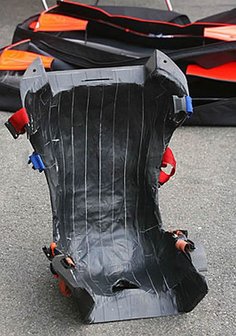 The FSAE Rules Committee decided to implement a modified version of the FIA Formula 1 cockpit template for use in FSAE and FS events beginning 2009. I am not sure if the Committee understood that the F1 templates are there so the mandated Lear Safety Seat (right) can be removed from the chassis with the driver strapped in. This requirement makes for a very roomy cockpit in a FS car!
The FSAE Rules Committee decided to implement a modified version of the FIA Formula 1 cockpit template for use in FSAE and FS events beginning 2009. I am not sure if the Committee understood that the F1 templates are there so the mandated Lear Safety Seat (right) can be removed from the chassis with the driver strapped in. This requirement makes for a very roomy cockpit in a FS car!
Whether teams like it or not, the rule is now in place and is the same for all teams. The templates were trialled at FSAE Australasia in December 2008. It was not necessary for cars at that event to meet the template rules, however, several teams had the potential to compete at 2009 events, and so built cars to meet the template rule.
Five cars were checked for 2009 cockpit compliance and none complied! This is not as bad as it sounds, as most failures were due to small or moveable components being in the way. Only one car failed that could not have been brought into compliance when it was found that the cockpit was too short by about 1 centimetre.
Typical failures were where the bolts used to mount the suspension inner points were too long or where wiring harnesses or control cables interfered with the templates. Teams should be aware they must make provision for these inclusions.
The questions to the Rules Committee point out the most common problems being experienced by teams. Complaint number one is certainly related to the steering rack.
Simply stated, the rack can not be removed for the template compliance test! This means the template must pass above or below the rack or the rack must be mounted outside the foot-well.
All 2009 cars I have seen to date have the steering mounted low in the foot-well, and the template passes over it. This brings the question “Can the template be moved vertically as it is moved forward (to clear the floor mounted rack)”?
The answer is “Yes, by a small amount”. At FSG, that ‘Small amount’ has been determined to be 50mm.
The top corners of the template can protrude between the tubes of a space-frame car, however, any such car would be carefully scrutinised for compliance regarding keeping the drivers feet within the structure at all times.
There is a slot or flap in the foot-well template to allow it to be inserted without having to remove the steering column. The template can be inserted and moved forward until the template touches the column, then removed and inverted before being placed on the other side of the column to complete the test.
The forward limit of the template is an imaginary plane 10mm from the pad of the pedals with the pedal box (if moveable) in the most forward position.
The cockpit template is lowered into the cockpit and must enter freely between the cockpit opening sides (or frame tubes) There is no allowance to remove such components as the shifter mechanism to permit the template to pass.
If a car does not pass the template check at FSG, it will simply not be permitted to compete in any dynamic event! There are only two exceptions to this, they are the cars from Australia which competed at the 2008 FSAEA event and so are still within their 1 year FS/FSAE ‘life’. These cars would be permitted to compete if they failed the templates check, but would be penalised 35 points and be automatically disqualified from the Design Finals. However, both these cars are built to the 2009 rules and after their experience in Australia, will pass the template checks.
To make this clear, the 35 point penalty and admission to the dynamic events is not available to any car that made its FS/FSAE debut in 2009.
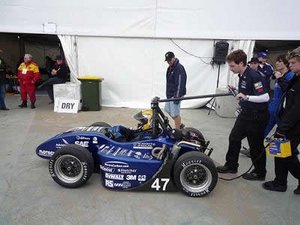 Incidentally, there was a fair amount of opinion that cars meeting the template rules would look like whales. This was not the case in Melbourne, where the Auckland car (right) and the RMIT car looked very stylish and the UWA car, although a little bulbous, wasn’t too bad. Whatever, FS cars with their short wheelbases and long front overhang nave never looked very good to me, even the best looking cars!
Incidentally, there was a fair amount of opinion that cars meeting the template rules would look like whales. This was not the case in Melbourne, where the Auckland car (right) and the RMIT car looked very stylish and the UWA car, although a little bulbous, wasn’t too bad. Whatever, FS cars with their short wheelbases and long front overhang nave never looked very good to me, even the best looking cars!
I understand these new rules make it very difficult, so how can a team design steering that will avoid bump-steer, permit the required amount of Ackermann and yet still pass the template?
As mentioned, most teams will mount the rack on the floor, or even below the floor, but there are some alternatives.
One option would be to mount the rack ahead of the front bulkhead and trail the tie-rods back to forward facing steering arms. The downsides of this solution include introducing bending forces in the rack, unplanned Ackermann effect and the possibility of the steering going over-centre on the outside wheel.
Another option would be to use a rack and bell-crank system similar to that used by Loughborough University in 2006. This system would permit mounting the rack out of plane with the steering arms without introducing bump steer. I suspect we will see some cars with this solution in August.
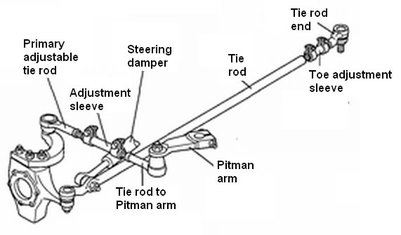
Thinking outside the box, is there a possibility that a team might choose not to use traditional Rack and Pinion steering?
There are many different steering systems used in production cars such as worm and sector or recirculating ball steering boxes. These use actuating linkages like this that might avoid having the steering box in the foot-well at all.
Research the Haltenberger linkage used on Ford pickup trucks with swing axle front suspension. Be warned though, direct connection of the wheels by a single tie-rod can lead to the dreaded ‘death wobble’ on occasions.
Maybe some team will come up with a different solution. Already, the Rules committee have been asked about hydraulic operation of the steering, but that has not been permitted.
Teams that have built ‘sidewinder’ cars like Lancaster (UK) and Deakin (Aus) are able to move the driver’s compartment back in the car without over extending the wheelbase. This permits the rack to be mounted in front of the pedals with no complication or compromise in steering geometry. With the increasing popularity of single and twin cylinder engines, perhaps this type of car will become more popular. In any case, unpopular though they may be, the cockpit templates have really stirred up the design compromises and it will be interesting to see the solutions offered.
Pat’s Design Error of the Month
Often we see inadequate rear toe control.
Shown here is a first year car from a country with no motor sport, so the error is understandable. Judges will demonstrate the compliance steer on a car like this by physically twisting the rear wheel. Usually, the students are surprised. A car with compliance steer like this will be very difficult to drive and impossible to drive fast.
Please ignore the other obvious issues with this car (below), I may use the picture to illustrate some other Design Error at some time in the future.
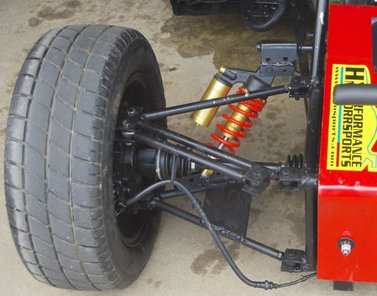
One would think that this design mistake would be confined to inexperienced teams, but how about the next picture?
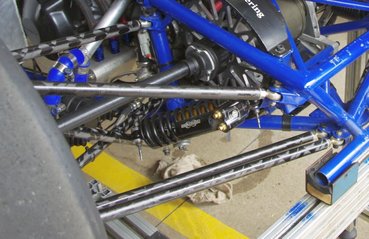
This car is from a very well credentialed team who have clearly forgotten some of the lessons learned in the past.
Until next time, Best wishes for 2009 and good luck with your design and build.


